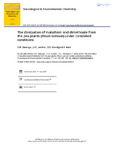The dissipation of malathion and dimethoate from the pea plants (Pisum sativum) under controlled conditions

View/
Date
2000Author
Jondiko, JIO
Getenga, ZM
Wandiga, SO
Beck, E
Metadata
Show full item recordAbstract
4C-malathion, [S-1,2-bis(ethoxycarbonyl)ethyl O,O-dimethyl phosphorodithioate] and 14C-dimethoate, [O,O-dimethyl S-(N-methylcarbamoylmethyl)phosphorodithioate] have been admin-istered to leaves of pea (Pisum sativum) plants under simulated tropical conditions in thegreenhouse. The results show that l4C-malathion dissipated faster than 14C-dimethoate fromthe leaf surface: After 16 days, 5.7% of the radioactive dose applied as malathion remained onthe surface of the treated leaves as surface (dislodgeable) residues. The extractable residuesconstituted 9% while the bound (non-extractable) residues were 4.2% of the total initial radio-activity. 16.7% of the initial dose had been translocated from the treated leaves to the rest of theplant. 17.1% of the initial dose constituted 14C-compounds other than 14CO2 recovered fromthe transpired water. The corresponding fractions of dimethoate were 21% dislodgeable, 17.4%extractable, and 5% bound residues. Only 4.6% of 14C-dimethoate residues were distributed inthe plant. Although dimethoate is 170 times more soluble in water than malathion, only 10.4%of the initial pesticide dose of dimethoate constituted 14C-compounds in the transpired water.Dimethoate formed dimethoxon, the oxygen analogue, while malathion did not form malaoxonin the plant, as revealed by thin layer chromatography (TLC) and confirmed by gas chromato-graphy-mass spectrometry (GC-MS)
